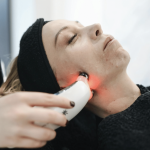Skin conditions are never fun to deal with. Even something as common as dry skin can become a nuisance. Dry skin can affect people of all ages, and conditions can range from itching to the appearance of flaky skin.
While dealing with dry skin can be frustrating, it doesn’t have to be a complicated fix. Thankfully, you can try multiple simple fixes to improve your skin’s health. Columbia Skin Clinic can help you learn about the types of dry skin and different methods to combat it.
Types of dry skin
Before learning how to treat dry skin, it’s important to know what is causing it and the different types. To put it simply, when skin does not have enough moisture, it dries out. Dry skin can cause widespread itchiness or be broken up into patches that are scaly and flaky to the touch.
When not caused by or identified as another skin condition, dry skin is referred to as xerosis or xeroderma. This type fits what most people think of when it comes to temporary or mildly dry skin.
Common dry skin conditions include:
- Contact dermatitis – When an irritant or allergen causes dry skin to develop
- Eczema – A skin condition that causes red, dry, bumpy and itchy patches of skin
- Seborrheic dermatitis – Dry skin that is mainly found on a person’s scalp but can also occur on the face, chest, belly button, arms, legs and groin
- Athlete’s foot – A fungus that causes dry skin on a person’s feet
What causes dry skin?
While some skin conditions can cause dry skin as a symptom, most dry skin is caused when the outermost layer of the skin, the epidermis, loses moisture.
As you go about your daily life, there are multiple ways your skin can inadvertently dry out that have nothing to do with other health or skin conditions. The most common ways skin loses moisture is through:
- Soaps and detergents
- Heat
- Climate
- Aging
- Medications
- Excessive bathing
Genetics and stress can also affect your skin and cause dryness. These factors can be more challenging to address.
Did you know? Before the 1840s, only the wealthy had indoor plumbing. Indoor showers started to appear in most houses in the 1930s to 1950s. Humans have never showered as often as we do now, leading to an increase in soap use and scrubbing, which can contribute to dry skin.
Simple ways to improve dry skin
The easiest method to address dry skin is to bathe less often. Many Americans bathe once or twice daily. In addition to water’s effect on the skin, most people scrub their skin with a washcloth or luffa because it feels good.
However, water rinses away much of the skin’s natural oils, and scrubbing can also cause dry skin. The more water comes into contact with the skin, the drier the skin becomes. Excessively hot water is especially drying, as are many soaps and cleansers.
Is your skin red, tight, itchy, cracked, peeling or rough or flaky to the touch? Reducing the number of hot showers or baths you take could be an easy dry skin treatment.
Certain foods like sugar, salt and caffeine can also contribute to dry skin. Avoid these foods or consume in moderation. We offer these nutrition tips to support healthy skin.
People with dry or itchy skin should also prioritize moisturizing and daily sunscreen use as part of their skin care routine. Moisturizers are most effective in the morning, evening and after a shower or bath.
When picking a moisturizer, knowing the best kind for your skin type and skincare needs is important. People with dry skin should aim to lock in moisture with a thick ointment, avoiding light lotion moisturizers that can worsen dry skin.
Dry skin home remedies
In addition to bathing less frequently and avoiding long hot showers, there are other ways to reduce the effects of dry or irritated skin at home:
- Stay hydrated – It’s somewhat of a myth that drinking plenty of water will prevent dry skin. But not drinking enough or sweating too much can certainly cause dehydration. Water keeps your body hydrated and refreshed, helping to maintain skin elasticity.
- Choose fragrance-free products – Perfumes and scents often contain compounds that can be problematic for sensitive or reactive skin.
- Check your laundry detergent – Some individuals are allergic to ingredients in laundry detergents. The allergic reaction can trigger dry, scaly or cracked skin. Seek out a detergent that is allergen-free and non-irritating.
Get professional help from a dermatologist
If your dry skin does not improve or your condition worsens, even after trying these tips, seek professional help. A board-certified dermatologist can recommend specialized treatments or may diagnose a specific skin condition. A dermatology professional can also help you reach your skincare goals and provide insights into the success of your daily regime.
If you have questions about dry skin, the team at Columbia Skin Clinic is here to help. Contact us today to schedule an appointment at one of our offices in Columbia, Irmo, Lexington or Camden.






